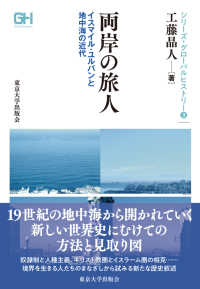- ホーム
- > 洋書
- > ドイツ書
- > Mathematics, Sciences & Technology
- > Earth Science
- > geography
Full Description
This book highlights the knowledge about landscapes and characteristics of the earliest hunter-gatherer lifeway in Southern Patagonia. It presents an analysis of the archaeological investigations carried out during three decades by an interdisciplinary team that involved archaeologists, anthropologists, paleontologists, geologists and specialists in pollen and diatoms. The database yielded was recovered from systematic survey and excavations from the Pleistocene and Holocene stratigraphic layers of the rockshelter known as AEP-1, Piedra Museo Locality, situated in the central plateau of Santa Cruz Province, Argentina. Piedra Museo is a unique place in the world of high academic interest with some of the earliest archaeological remains in the Americas.
Researchers defined two strata and several Stratigraphic units in the site based on the sedimentological and pedological characteristics. The depositional zones contain archaeological remains that are interpreted as hunting events corresponding to two main different occasions in the human colonization of the region, and a third human occupation during the Middle Holocene. Last one occurred then of the massive rockshelter roof colapse. The faunal remains led to a new approach to the palaeoenvironmental evolution of this enclosed basin. This volume describes the management of lithic raw materials and social networks from first human occupation of the Patagonian region to territorial consolidation of hunter-gatherer societies.
Contents
Chapter 1. Piedra Museo, a place and a history of the peopling of Patagonia(Laura Miotti).- PART I. PALAEOENVIRONMENTS and PALEOECOLOGY.- Chapter 2. Last Glacial Maximum, Late Glacial and Holocene of Patagonia(Jorge Rabassa, Andrea Coronato, Oscar Martínez, Agustina Reato).- Chapter 3. Geoarchaeology of Piedra Museo locality(Marcelo Zárate, Bruno Mosquera, Adriana Blasi, Florencia Lorenzo).- Chapter 4. Radiocarbon Chronology at the AEP-1 rockshelter in Piedra Museo Locality: update and discussion of the datings(Laura Miotti, Bruno Mosquera, Mónica Salemme, Jorge Rabassa).- Chapter 5. Quaternary fossil vertebrates of Tierra del Fuego and southernmost Patagonia(Germán Gasparini, Eduardo Tonni).- Chapter 6. Late Pleistocene and Holocene palaeovegetational changes at Alero El Puesto (AEP-1) archaeological site in the northern Deseado Massif. Regional palaeoenvironmental implications and Early human occupation(Ana Borromei , Lorena Musotto).- Chapter 7. Diatom analysis of Piedra Museo paleolake, Santa Cruz, Argentina(Marilén Fernández).- PART II. ARCHAEOFAUNAS, LITHIC MATERIALS AND ROCK ART.- Chapter 8. The archaeofauna of Piedra Museo. Archaeological and taphonomic study of the AEP-1 site (Argentine Patagonia)(Laura Marchionni, Martín Vázquez, Laura Miotti).- Chapter 9. The Rheids as a Palaeoenvironmental and Consumption Indicators during the Latest Pleistocene and the Middle Holocene(Mónica Salemme, Laura Miotti).- Chapter 10. An Isotopic Perspective of the Alero El Puesto 1 Zooarchaeology: Environmental Changes, Extinct Fauna and the First Human Occupations of Southern Patagonia(Augusto Tessone).- Chapter 11. About humans and rocks at the end of the Southern Cone. A lithic technology overview at Piedra Museo locality(Roxana Cattáneo).- Chapter 12. Stone Tools Production and use in AEP-1 site of Piedra Museo locality, Patagonia(Virginia Lynch).- Chapter 13. The retouched toolsof the lower componente of AEP-1 (Piedra Museo, Argentina) from a perspective of design(Darío Hermo).- Chapter 14. Back to a time perspective: new insights for the study of Piedra Museo's ancient rock art, Patagonia, Argentina(Natalia Carden).- PART III. PIEDRA MUSEO IN THE XXI CENTURY.- Chapter 15. Challenges for the 21th. Century: The Patrimonialization of Piedra Museo(Laura Miotti, Lucía Magnin, Enrique Terranova).- Chapter 16- To the End of the World: Southern Patagonia in Models of the Initial Peopling of the Western Hemisphere(Ruth Gruhn).- Chapter 17. Opposites Attract: Why a Bi-polar, Hemispheric Perspective to the Peopling of the Americas is Needed(Ted Goebel).- Chapter 18. Concluding Remarks and New agenda(Laura Miotti, Darío Hermo, Mónica Salemme).




